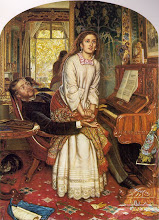
Some clever soul has written a Facebook program called "Musicology is Awesome," which allows musicologically-inclined Facebook users to send gifts like "Challenging Austro-Germanic Musical Hegemony," "That Dreaded Cultural Theory Reading Assignment," and "Illegible Cantata Manuscript" to their friends, who will only find these gifts funny if they're also musicologists.
Up until about thirty years ago, musicology was Austro-Germanic Musical Hegemony and Illegible Cantata Manuscripts, but, since the advent of the "new musicology," its focus has widened to embrace many musics (the new-musicological noun of choice), and it has become largely driven by Dreaded Cultural Theory. There are both good and bad aspects to this gradual transformation of a formerly stuffy discipline: among the bad are an overreliance on unconvincing post-structuralist theory and jargon, and tediously long articles in the Journal of the American Musicological Society, but among the good are the expansion of the canon of musical repertoire for serious scholarly study to include some wonderfully worthy genres that would have been laughed at thirty years ago. Also among the good (depending on how you look at it) is the fact that not everyone has to deal with Illegible Cantata Manuscripts anymore. Virtually all of the lost medieval and Renaissance manuscripts have been found (and their finding has been the basis of many a music scholar's career), which means that musicologists have to find other things to do, and there are lots of other things.
The bulk of my musical work as both performer and scholar has been in nineteenth-century music. It's great fun, if you're so inclined, to do research in the era known as "the long nineteenth century" (considered roughly to span the years between 1789 and 1914): documentary sources are numerous and well-preserved, and it's fascinating to peer into an era that, with the exception of advances in technology, was so strikingly similar to our own. In terms of performance practice, there is ample documentation in sound from the early days of recording, as well as notebooks, diaries, and musical sketches by composers and performers, as well as letters and reviews, that enable us to construct a reasonable notion of how nineteeth-century music sounded in its own day (this is not the case with, say, early music, whose performances, many of which strive for historical verisimillitude, are largely based on unverifiable conjecture about the performance practices of the day). We know, for instance, that Rossini hated it when singers interpolated notes above high C into his arias: he called this practice "singing in hair voice" (voce di capelli). And we can guess at the ornamentation style of the bel canto era from the earliest extant recordings, including this one by soprano Luisa Tetrazzini, which most modern connoisseurs would find tacky, if not cheeky. And we can wonder at the tempo and technique employed by the great Josef Joachim, friend and colleague of Johannes Brahms.
Unlike her interpretive style, Luisa Tetrazzini's vocal technique is not appreciably different from that used by singers today. But Joachim's extraordinarily pure tone and eschewing of vibrato are a different story. People just don't play the violin like that today, which indicates that not only music, and but also culture itself, were perceived differently a hundred years ago.
But analyze as we might, the one thing that we can never really know is what the world sounded like in the nineteenth century. What was it like to live at a time when the sounds of the countryside were gradually and then definitively supplanted by the cacophonous din of the city? What was it like when the first inventions for the amplification and transmission of sound -- the microphone, telegraph, gramophone -- were introduced? How did people hear the world before and after these new technologies? And how does our own hearing differ from that of our near ancestors?
In Brahms's day, the contralto was a common female voice type. He wrote his Alto Rhapsody for the great contralto Pauline Viardot, the younger sister of the great contralto Maria Malibran, and he wrote many of his most beautiful songs for the contralto Amalie Joachim, wife of the violinist, including the two op. 91 songs for alto, piano, and viola. But the contralto voice is virtually unknown now. Is the reason for its disappearance to be found in the way we hear the world?
To be sure, there are a few exceptional contraltos singing today, but they can be counted on one hand, and our age has a marked preference for higher, lighter voices in both women and men: witness the enduring popularity of soubrette-type sopranos like Kathleen Battle, Barbara Bonney, Anna Netrebko, and Dawn Upshaw (though, admittedly, Upshaw has expanded her repertoire far beyond what is typically sung by others in her vocal category), and the dubious rise of the countertenor over the past fifteen or so years. Is the shift away from darker to lighter voices a sign of progress or of a deficiency in our culture?
I'm inclined to think the latter. The virtual disappearance of the contralto voice -- deep, dark, womanly -- is, I think, like the disappearance of the blackbird from mid-nineteenth-century London, one of many small but sad outcomes of the stepped-up mechanization of modern life.
Here's a stirring example of what we've lost. Marian Anderson is like a vocal version of Joachim's violin: pure and radiant.
(Above: Brahms taking a walk, Vienna, c. 1880s.)











No comments:
Post a Comment